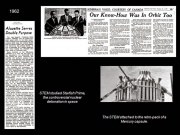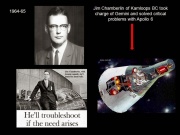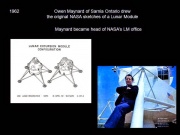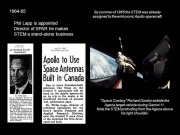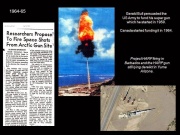100 Years of Aerospace History in Canada: From McCurdy to Hadfield Part 7 by Robert Godwin
From The Space Library
STEMs around the World, the USAF gets Churchill and Gerald Bull's Gun
Just four days after the successful launch of Alouette, STEM antennae flew into space aboard Sigma 7.[i] In a clear indication of the times, Lapp's team had built and shipped them on an emergency basis, they were installed by McDonnell and flown as a backup to Schirra's main comm-system.
Communication was vastly improved by the dipole capability of STEM. Schirra later commented in his debrief, "When I made HF checks, I’m sure that I was in dipole. I heard all sorts of stuff on the HF checks. I heard people talking all over the world. Frankly, I wasted too much time on other occasions trying to call people back saying I heard you."
One of the little known functions of Alouette was also to study the remnants of Starfish Prime, the United States' space detonation of a nuclear warhead, which had taken place the previous July.[ii]
Some concern had been raised about launching Schirra into the region where the nuclear test had left a trail of radiation trapped by the Earth's magnetic field. Some satellites were completely disabled by this radiation and indeed the electro-magnetic pulse had caused black-outs in Hawaii. Alouette was the perfect instrument to study these artificially created radiation belts.
STEMs soon became integral to the Gemini, America's two-man spacecraft, which had revolutionary design features provided by James Chamberlin of Avro, another University of Toronto graduate. The STEMs for Gemini had to be stronger and more complex so that they could be used as recovery antennae, which deployed after reentry, and could withstand the waves in the ocean. STEM was also highly visible on the Agena target vehicle.[iii]
The many Canadians from Avro who had taken posts at NASA had now mostly moved to Houston. They were keeping very busy on the Gemini and fledgling Apollo programs.
In the spring of 1962, Owen Maynard, one of the Avro Arrow team and yet another University of Toronto graduate, was managing the lunar lander office for NASA.
In April of that year Maynard drew up his ideas for a manned lunar landing vehicle. Later that year Grumman won the contract to build the Lunar Module and renowned Grumman president Tom Kelly would work closely with Maynard for the next seven years. Kelly's team often referred back to Maynard's original design during their legendary seven year battle to build the LM.
In 1964 noted Soviet space academician Leonid Sedov visited DeHavilland at Downsview and was given a briefing on STEM. At the time Dr Lapp was suspicious of Sedov's motives and found his questions about STEM to be "too penetrating" so he cut the tour short. Despite his sense of unease Sedov was allowed to leave with a small piece of STEM beryllium/copper as a souvenir.
Three years later Dr Lapp noticed that Sedov's team had reverse engineered the STEM and they were on display on all of the Soviet satellites at EXPO 67. Lapp later confronted their spokesman (who he felt had been making some unwarranted claims about superior Soviet technology) by pointing out on live television that all of their satellites had Canadian designed antennae.[iv]
By the 1970s thousands of STEMs of different shapes and composition were flying in space. Indeed, STEMs were attached to the early Soviet probes sent to Mars.
Later STEM would be installed on the Hubble Space Telescope and aboard the service modules of the last three Apollo moon missions. John MacNaughton, VP of SPAR, would later say that STEM is what gave SPAR the influence and leverage to sell NASA on the Canadarm.[v]
In 1962 responsibility for Churchill was turned over to the USAF. This was consistent with the trends in the United States in the early 1960s. The Army's role in missiles was rapidly diminishing. The von Braun missile team had been turned over to NASA on July 1st 1960. From that point forward missile and rocket launching activities rapidly fell under the purview of the US Air Force and NASA.
The schism between the Air Force and the Army over who should control missiles had first happened in Nazi Germany, then in the Soviet Union and finally in the United States. In the case of the USA, the Air Force and their contractor lobbyists, had successfully pushed the Army out of the missile business, all that was left for the Army was artillery.[vi]
While Canada's space program was now following the conventions already laid down by the Soviets and the Americans, at least one engineer had more ambitious plans for Canada and was willing to take advantage of the US Army's recent deprivation.
As early as 1959 Gerald Bull, now a research scientist at CARDE, had entered discussions with the US Army's Ballistic Research Laboratory to build a gun capable of high velocity space launch capability. By 1962 Bull had moved to McGill University in Montreal and had persuaded the US Army, which was now more-or-less out of the missile business, into financing his design for a gun launch system.
In the summer of 1962 a 16 inch gun, along with its requisite equipment was transported to Barbados to be installed there for test firings. A second 16 inch gun was later shipped to Quebec to be installed near to the Vermont border and to be used for horizontal test firings, while a third would later be installed in Yuma Arizona.
Bull had increased his expertise in the field of large calibre artillery when he had helped in the development of the Avro Arrow. Bull had been firing sabots and missiles from Point Petre in Ontario in the mid to late 1950s.[vii] He was also involved in the firing of large rockets carrying scale models of the Arrow; many of which landed in Lake Ontario.
Bull's large gun was christened Project HARP (for High Altitude Research Program.) By 1966 HARP also had its installation in Yuma Arizona operational where a 120' long HARP gun was shooting payloads to altitudes of 180km. There weren't many useful payloads that could withstand the acceleration loads of a HARP launch, which under certain circumstances could exceed 60,000g's.
However, more than one payload successfully transmitted data from space after being launched by HARP. Delicate payloads were out of the question, but one experiment considered perfect for HARP was to explode a canister of dust, just before reentry, to simulate a nuclear reactor breakup in space. This was similar to Project High Water, an experiment conducted the same year, in which von Braun and NASA had exploded a tank of water at high altitude for research purposes.
Footnotes
[i] Globe and Mail Oct 4 1962
[ii] Ibid. Oct 6 1962
[iii] Phil Lapp Memoir pg 155
[iv] Ibid. pg 170
[v] Ibid. Pg 157
[vi] Countdown for Decision, MG J.B. Medaris, Putnams, 1960
[vii] Phil Lapp Memoir Pg 111
